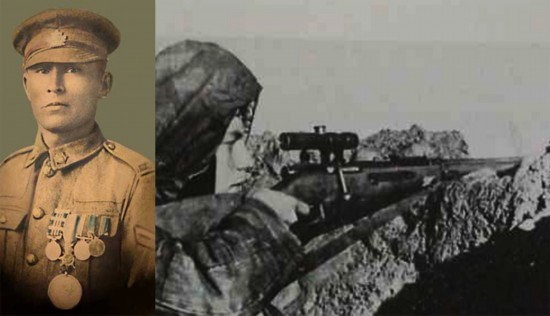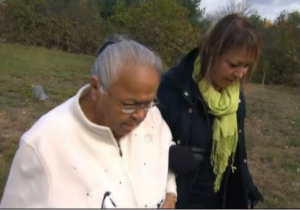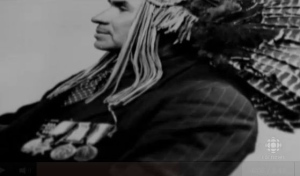 |
Canku Ota
|
 |
|
(Many Paths)
|
||
|
An Online Newsletter
Celebrating Native America
|
||
|
September 2014 - Volume
12 Number 9
|
||
|
|
||
|
Legendary Ojibwa
Sniper Unsung Hero of WW I
|
||
|
by Reg Sherrin - CBC
News
|
||
|
He was the most decorated First Nations soldier in the history of the Canadian military, but very few people have ever heard of Francis Pegahmagabow.
From the time he signed on in September 1914, until the war ended on Nov. 11, 1918, Francis fought. In fact, of the over 600.000 Canadians who served, he was one of only 39 in the Canadian Expeditionary Force to be awarded the Military Medal and two bars for valour.
"He was a good man," says his daughter-in-law, 81-year-old Priscilla Pegahmagabow, visiting the cemetery with the help of her daughter, Teresa McInnesPegahmagabow. "[It's] very sad, that I didn't get to know him," says Teresa, who was born just a few weeks after Francis Pegahmagabow passed away. He was a proud member of the Wasauksing First Nation, a musician who, as a young man, also worked on the lake boats as a marine fireman. On one trip, as legend goes, an Ojibwa medicine man told him he would face great danger and gave him a leather medicine pouch to keep him safe..
Then came the First World War, and the call to arms. Early in the war, the Canadian government decided to exclude native Canadians from military service but Pegahmagabow somehow managed to slip through. He was one of the first to sign on with the 23rd northern Pioneers overseas contingent. He would quickly learn just how brutal this "war to end all wars" would be. Trench warfare, deadly German gas attacks, horrific shelling. Through it all the young warrior's reputation grew. "He believed that nothing could happen to him," said Adrian Hayes, the author of the definitive biography of Pegahmagabow. "Whether you believe these stories about medicine pouches or not, he believed it, and I think that's why he acted the way that he did…and how he got through it." As a sniper, he was deadly accurate, and although difficult to substantiate, he was credited with 378 kills, as well as the capture of 300 prisoners. His first military medal came in 1916, for facing enemy fire repeatedly to dispatch critical messages. There would be another at Passchendaele in 1917 and yet another for climbing out of a trench under gunfire to resupply ammunition. Shot once in the leg, downed by pneumonia, he kept on fighting, even when shellfire practically buried him alive.
When it was over, Francis Pegahmagabow had become the most highly decorated aboriginal soldier in the history of the Canadian military. He returned a hero, but it wouldn't last. "When he was in uniform he was considered an equal…by what he could do. When he came back, he just went back to being an Indian. Indians at that time were not even Canadian citizens. They were treated like children and the Indian agents wanted him to basically sit back and shut up and not say anything." It's not something his family likes to talk about now. The war hero faced poverty and persecution, usually at the hands of Indian agents who controlled even his pension, and seemed to block every attempt he made to get ahead.
Francis Pegahmagabow died at 64, his lungs damaged so badly that he had to sleep in a chair to keep them from filling with fluid. On Aug. 5, 1952, a heart attack finally claimed the man his enemies never could.
But decades later his legacy lives on in his granddaughter, Teresa, who serves on Wasauksing's band council, and in the many young people who have gone on to sign up to serve. In 2006, over 80 years after he served, the military finally decided to recognize him, erecting a monument at CFB Borden, and with full military honours, named the building of the 3rd Canadian Ranger Patrol group after him. "I like to think of him as being a warrior in the First World War for Canada," said Sgt. Peter Moon of CFB Borden, "and then he came back and because of the way he was treated, he became a warrior for his own people, and he suffered greatly in both capacities." "He was standing for equality, not just for natives, but for all Canadians," said his biographer, Adrian Hayes. He was a real Canadian hero, but to Teresa he's the grandfather she never knew, and yet, she says he's somehow been with her all her life. "I'm sure he's watching over his family as we do his story … he thought a lot of this First Nation and I'm sure he'll be watching over us." |
|
|
||
|
|
||
| Canku Ota is a free Newsletter celebrating Native America, its traditions and accomplishments . We do not provide subscriber or visitor names to anyone. Some articles presented in Canku Ota may contain copyright material. We have received appropriate permissions for republishing any articles. Material appearing here is distributed without profit or monetary gain to those who have expressed an interest. This is in accordance with Title 17 U.S.C. Section 107. | ||
|
Canku Ota is a copyright ©
2000 - 2013 of Vicki Williams Barry and Paul Barry.
|
||
 |
 |
|
|
The "Canku
Ota - A Newsletter Celebrating Native America" web site and
its design is the
|
||
|
Copyright ©
1999 - 2013 of Paul C. Barry.
|
||
|
All Rights Reserved.
|
||

 In
a quiet corner of the old cemetery on Wasauksing First Nation, his
military stone stands alone, But the legend of Cpl. Pegahmagabow
has lived on this reserve now for almost a century.
In
a quiet corner of the old cemetery on Wasauksing First Nation, his
military stone stands alone, But the legend of Cpl. Pegahmagabow
has lived on this reserve now for almost a century. He
had six children with his wife, Eva. Twice, he was chief of his
band, always sending letters to Ottawa — even to the prime
minister — demanding better treatment. Eventually he helped
to form some of the first national native rights movements in Canada.
He
had six children with his wife, Eva. Twice, he was chief of his
band, always sending letters to Ottawa — even to the prime
minister — demanding better treatment. Eventually he helped
to form some of the first national native rights movements in Canada.